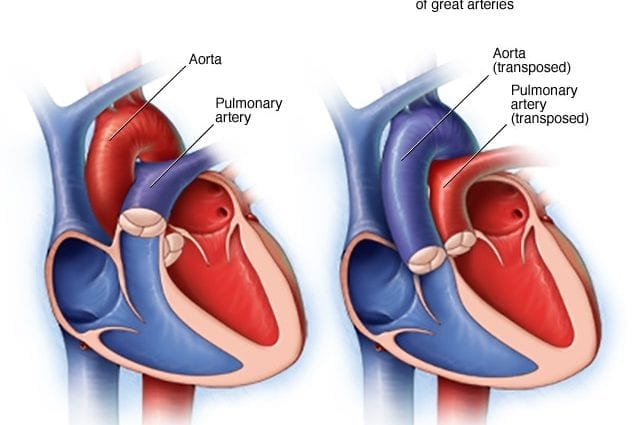General description of the disease
This is a very rare anomaly of natural origin, in which all internal organs or any one single organ are arranged in a mirror order.
That is, the organs are located the other way around: the heart is on the right side, and not as we are accustomed to on the left, the gallbladder and liver are located on the left side, and the stomach with the spleen are located on the right. This reverse position can also affect the lungs. With lung transposition, there will be a three-lobed lung on the left, and a two-lobed lung on the right. This also applies to all blood and lymph vessels, nerves and intestines.
Prevalence and types of transposition of internal organs
If the apex of the heart is directed to the right, and all other organs are located in a mirror image, such an anomaly is called organ transposition with dextrocardia.
If the heart is located on the left side of the chest, and all other internal organs are inverted, then such cases are called organ transposition with levocardia.
The first type of anomaly is more common, with dextrocardia occurs in 1 person in 10 thousand. With the second type of transposition for 22 thousand people, only one person with levocardia occurs.
Organs located in a mirror image in comparison with the normal position of organs with levocardia and dextrocardia without transposition of internal organs are very dangerous for human life.
Reasons for the reverse arrangement of organs
Medical workers have not yet established any reasons for the development of such a serious natural anomaly.
The location of the organs is not influenced by the age of the parents, nor by nationality, nor by genetics. All such special people have children with a normal arrangement of internal organs. This means that transposition is not a hereditary disease.
Scientists have noticed that relatively many cases of dextrocardia occur in people with trisomy on the thirteenth chromosome (with the so-called Patau syndrome). In this case, only the heart is located in reverse, and all unpaired internal organs are located in a normal order.
Symptoms and diagnosis of organ transposition
If a person does not have a congenital heart defect, then no specific arrangement of organs can be detected by external signs.
Many people find out about their characteristics after many years of life, when they are faced with some serious health problems that do not at all relate to organ placement.
With congenital heart disease, the baby is immediately diagnosed with transposition during cardiogram and ultrasound.
In people with dextrocardia, congenital heart defects occur in 5-10 percent. With regard to transposition with normal placement of the heart (with levocardia), heart defects are detected in almost 95% of people.
Nowadays, so that a person knows his anatomical features, even at the age of several months, doctors prescribe medical examinations for babies in order to diagnose this anomaly early.
Complications of transposition of internal organs
The arrangement of organs in a mirror image, if a person does not know about it, often makes it difficult to make a correct diagnosis. After all, all the signs and symptoms (pain in the side, abdomen) will occur from the “wrong” side. Let’s say a person with transposition will develop appendicitis, he will have complaints of pain in the lower left corner of the abdomen; there will be problems with the spleen, the doctor may attribute it to liver or gallbladder problems.
Therefore, it is extremely important to know about your anatomical features. In the West, people with such features wear special key rings, bracelets or tattoo with an accurate diagnosis and type of transposition.
The area of transplantation in people with transposition causes great difficulties. After all, basically, donors are people with the correct location of internal organs and blood vessels. Replacing one organ with another in the presence of a reverse location is a very complex process and requires a highly qualified transplant doctor, because correctly located vessels and nerves must be turned out mirror-like so that the new organ takes root and does not break away.
Useful foods for organ transposition
In the absence of heart defects or other congenital diseases, a person can lead a completely normal life. Food should be high-calorie, healthy, contain all macro- and microelements, vitamins, enzymes required for normal human life.
If you have any diseases, you need to adjust your diet depending on the problem identified. Any form of nutrition or diet should be discussed with qualified medical personnel who will indicate all recommendations.
Traditional medicine for organ transposition
With organ transposition, folk remedies can only act as an addition to solving a problem that has overtaken such a “special” person.
For any serious violations in the functioning of an organ, qualified medical attention is required. In no case should one independently diagnose and prescribe therapeutic therapy. If you do not know about your peculiarity, you can “heal” a healthy organ, but the affected organ will continue to hurt and the disease will only progress. Diagnostics should be carried out using medical examinations and modern equipment.
Dangerous and harmful products from organ transposition
A person with a mirror-like arrangement of organs is strongly advised to lead a healthy lifestyle and include only healthy foods in their diet. Alcohol, tobacco, trans fats, spreads, herbal mixtures, sugary sodas, fast food, and all other non-living foods should be excluded from the diet.
In the presence of allergic reactions, products containing allergens should be excluded. The list of harmful products can be extended due to other congenital or acquired diseases. A personal approach to each person individually is important here, taking into account all the characteristics of his body.
Attention!
The administration is not responsible for any attempt to use the information provided, and does not guarantee that it will not harm you personally. The materials cannot be used to prescribe treatment and make a diagnosis. Always consult your specialist doctor!










